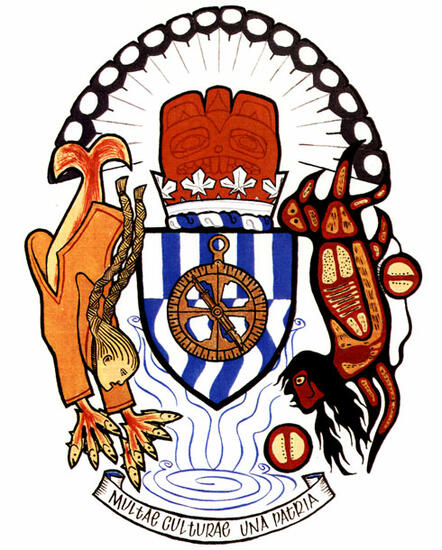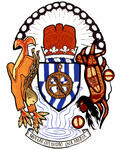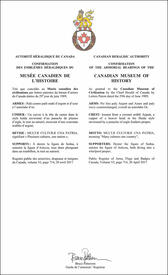The contents of this Register are intended for research purposes only. The heraldic emblems found in the Register may not be reproduced in any form or in any media without the written consent of the Canadian Heraldic Authority and/or the recipient.
Gatineau, Quebec
Confirmation of Arms and Supporters
April 20, 2017
Vol. VI, p. 714
Arms of Canadian Museum of HistoryBlazonPer fess paly Argent and Azure and paly wavy counterchanged, overall an astrolabe Or; SymbolismThe vertical lines evoke the Chaudières Falls, which French explorer Samuel de Champlain described in 1613 during his travel up the Ottawa River, nearby the current site of the Canadian Museum of History. The water symbolizes the country’s natural resources in addition to recalling the importance of waterways, for centuries the main trade and communication routes for both the Indigenous peoples and European settlers. The astrolabe, a symbol of European exploration, represents the instrument in the museum’s collection believed to have been lost by Champlain on his journey to the country of the Huron. |
CrestBlazonIssuant from a coronet erablé Argent, a copper of a beaver head in the Haida style environed by a panache of eagle feathers proper; SymbolismA traditional symbol of Canada noted for its industrious skills, the beaver was a major family emblem of Pacific Coast First Nations. This beaver image is taken from a ceremonial copper in the collection of the museum bearing the mark of Chief Ninstints, of the Haida people. The fan of eagle feathers is a traditional symbol of honour of the Plains First Nations. The maple leaf is one of Canada’s national emblems. |
MottoBlazonMULTÆ CULTURÆ UNA PATRIA; SymbolismThis Latin phrase, meaning “Many cultures one country”, recalls the museum’s mandate to preserve and promote the cultural traditions which define Canadians. |
SupportersBlazonDexter the figure of Sedna, sinister the figure of Asticou, both diving into a whirlpool proper; SymbolismOn the left, Sedna, the guardian of sea animals in Inuit culture, represents the First Peoples of Canada’s North; she is styled after a work by Inuit artist Manasie Akpaliapik. On the right, Asticou, an Algonquian merman said to live below the Chaudières Falls, represents the First Nations of Eastern Canada; he is styled after a work by Anishinaabe artist Norval Morrisseau. Both spirits are depicted diving into a whirlpool, which represents the power of nature in its elemental state. |
Additional InformationCreator(s)Original concept of Robert D. Watt, Chief Herald of Canada, assisted by the heralds of the Canadian Heraldic Authority. PainterKathryn Adams CalligrapherKathryn Adams Recipient TypeCivil Institution
Other InformationThe recipient’s emblems were originally recorded in the name of the Canadian Museum of Civilization in the Public Register of Arms, Flags and Badges of Canada, Volume I, page 20, 29 June 1989. |



